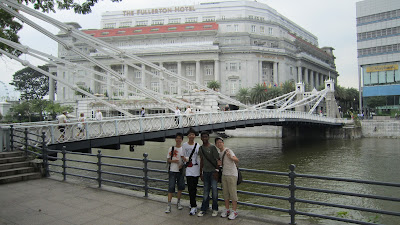Anderson Bridge
The bridge is the Anderson bridge. This bridge was constructed to lighten traffic on the Cavenagh Bridge which linked the government district. It was then used for ox and heavier vehicles to cross. During the Japanese occupation, criminals were hung on the bridge too.
Raffles landing site
Sir Stamford Raffles' Statue, sculpted by Thomas Woolner, is a popular icon of Singapore. The statue depicts Raffles, standing tall, arms folded, with an aura of quiet assurance. It was installed on Jubilee Day on 27 June 1887 at the Padang and relocated to the Empress Place during the Centenary Celebrations on 6 February 1919.
A metal plate on the raffles's statue
Facts that i bet you didn't know
The statue was moved to the front of the Victoria Memorial Hall on 6 February 1919. The statue was placed such that it looked toward the assumed place of Raffles' original landing at the mouth of the Singapore River. It was also carefully positioned axially with the centre of the clock tower of the Victoria Hall.
During this move, the base of the statue was found to be supported by a rod which went through one leg of the statue. The corrosion which occurred around it was duly repaired before the move. A tablet was placed at its plinth, recognising the special importance of Raffles in Singapore for the Centenary Celebrations. Raffles' Arms and the Knight's motto were engraved on a bronze shield placed at the base of the granite pedestal. A cast of the statue's head was also made for a bust to be located at the Raffles Museum and Library. This bust is not the same as the plastercast replica of Chantrey's bust of Raffles, which was also located at the Raffles Museum and Library.
Parliament
In the above picture we can see the Parliament. This is the new Parliament building. It was finished in July 1999 with a final bill of $115.2 million. It is still in operation and used.
In the above picture we can see the Parliament. This is the new Parliament building. It was finished in July 1999 with a final bill of $115.2 million. It is still in operation and used.
Elgin BridgeSingapore's first bridge was erected around 1819 where the current Elgin Bridge stands. In November 1822, a wooden footbridge called Presentment Bridge, also known as Monkey Bridge, replaced this original crossing. After many repairs to the Presentment Bridge between 1827 and 1842, it was demolished. In 1844, it was replaced by another wooden footbridge designed by J. T. Thomson, and the bridge was renamed Thomson's Bridge. In 1845, this was widened (inside of the railing, 18 ft long, 1 in broad) and modified to take carriages. By 1862, the Thomson's Bridge was replaced by an iron bridge imported from Calcutta. Renamed Elgin Bridge in 1863, in honour of Lord Elgin, the Governor General of India (1862- 1863), it was erected with contributions from George Lyon, a shipbuilder from Tanjong Rhu.








No comments:
Post a Comment